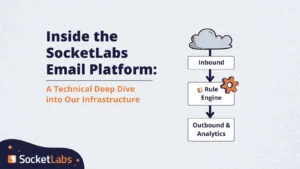
Today you’re going to learn exactly whether you should be using SMTP or IMAP. In fact, there is a major difference between the two protocols. In this article, we’ll help you understand the differences between SMTP and IMAP. We’ll also briefly touch on POP3.
Let’s get started.
- What is SMTP?
- What is IMAP?
- What Is An Example of SMTP & IMAP Working Together?
- What is POP3?
- How to Send Outgoing Email With SMTP
What is the difference between IMAP and SMTP?
IMAP is for the retrieval of emails and SMTP is for the sending of emails. That means IMAP talks to both the client and server to get emails, and SMTP talks only to servers to send emails.
What is SMTP?
SMTP stands for Simple Mail Transfer Protocol and it’s the industry standard protocol for email sending.
With SMTP you are sending, relaying, or forwarding messages from a mail client (like Microsoft Outlook) to a receiving email server. A sender will use an SMTP server to carry out the process of transmitting an email message.
The key thing to keep in mind when thinking about whether to use SMTP or IMAP, is that SMTP is about sending email. So, if you’re looking to enable email sending within your application, then you’ll want to go ahead with using SMTP over IMAP.
What is IMAP?
If SMTP is all about sending, then: What is IMAP?
Simply put, IMAP (Internet Access Message Protocol) is an email protocol that deals with managing and retrieving email messages from the receiving server.
Since IMAP deals with message retrieval, you will not be able to use the IMAP protocol to send email. Instead, IMAP will be used for receiving messages.
Example of SMTP & IMAP Working Together
Whether you’re sending a transactional email like a password reset, or you’re receiving a paycheck notification — chances are that you’re using both SMTP and IMAP.
Here’s how SMTP and IMAP work together to transmit an email message:

- After creating an email and pressing ‘send’, your email client (e.g. Gmail, Thunderbird, Outlook, etc.) will use SMTP to send your message from your email client to an email server.
- Next, the email server will use SMTP to transmit the message to the recipient’s receiving email server.
- Upon a successful receipt of the SMTP transmission (indicated by a 250 OK response code), the recipient’s email client will fetch the message using IMAP and place it in the inbox for the recipient to access.
What is POP3?
In addition to IMAP, there’s also another protocol for receiving email — it’s called POP3.
POP stands for Post Office Protocol.
And the number three stands for “version 3,” which is the latest version and the most widely used — hence the term “POP3.”
What is the difference between POP and IMAP?
POP vs IMAP
Remember POP and POP3 are the same thing, POP3 is the most recent version of POP, which stands for Post Office Protocol.
POP3 vs IMAP
POP3 downloads the email from a server to a single computer, then deletes the email from the server.
On the other hand, IMAP stores the message on a server and synchronizes the message across multiple devices.
Should you be using POP3 or IMAP?
It depends on how you want to access your emails.
Generally speaking, IMAP is more powerful and the recommended method for receiving email if you’re working across multiple devices.
Alternatively, if you prefer to have all emails accessible offline, and if you have a designated device for email, then POP could be a suitable option.
Summary of the SMTP, IMAP, and POP3 Email Protocols
To wrap up our blog post on using SMTP or IMAP, here’s a quick summary:
- SMTP is the industry standard protocol for sending email. If you’re looking to send email, then you’ll use SMTP instead of IMAP. An SMTP relay service can help you send email without having to build your own SMTP server.
- IMAP is one of the most common protocols for receiving email. IMAP syncs messages across all devices.
- POP3 is another protocol for receiving email on a single device. Using POP3 means that your email will be accessible offline and deleted from the server.
By now you should see that there are significant differences between IMAP, POP, and SMTP. Let’s discuss how to send with SMTP.
How to Send Outgoing Email with SMTP
As we’ve discussed throughout this article, IMAP is for receiving email while SMTP is for sending email. So, if you’re looking to send email, then you’re better off using SMTP over IMAP.
How to send email with SMTP:
The fastest and easiest way to get started with SMTP is to use an SMTP relay service like SocketLabs. A cloud based SMTP relay makes it easy to send email from your app or website, without having to build and maintain your own email systems.
Here’s how to get started:
-
- Grab your free trial of SocktLabs’ SMTP relay service
- Login to your account and locate your SMTP Credentials

- Plug your SMTP Credential into your application
That’s all there is to it! After you start sending you can track the performance of your outgoing email with our StreamScore Monitoring tool.

To get started with SMTP create your free account here.







